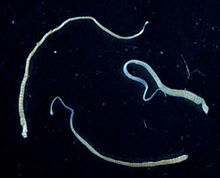
Hymenolepis nana

Dwarf tapeworm (Hymenolepis nana, also known as Rodentolepis nana, Vampirolepis nana, Hymenolepis fraterna, and Taenia nana) is a cosmopolitan species though most common in temperate zones, and is one of the most common cestodes (a type of intestinal worm or helminth) infecting humans, especially children. As its name implies (Latin: nanos – dwarf), it is a small species, seldom exceeding 40 mm long and 1 mm wide. The scolex bears a retractable rostellum armed with a single circle of 20 to 30 hooks. The scolex also has four suckers, or a tetrad. The neck is long and slender, and the segments are wider than long. Genital pores are unilateral, and each mature segment contains three testes. After apolysis, gravid segments disintegrate, releasing eggs, which measure 30 to 47 µm in diameter. The oncosphere is covered with a thin, hyaline, outer membrane and an inner, thick membrane with polar thickenings that bear several filaments. The heavy embryophores that give taeniid eggs their characteristic striated appearance are lacking in this and the other families of tapeworms infecting humans. The rostellum remains invaginated in the apex of the organ. Rostellar hooklets are shaped like tuning forks. The neck is long and slender, the region of growth. The strobila starts with short, narrow proglottids, followed with mature ones.
